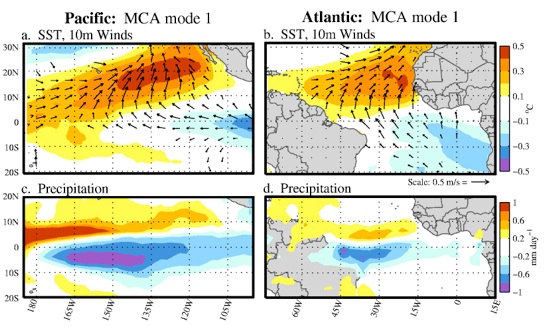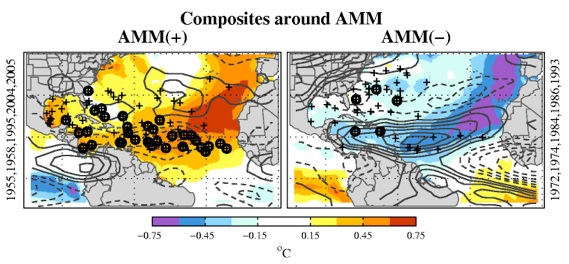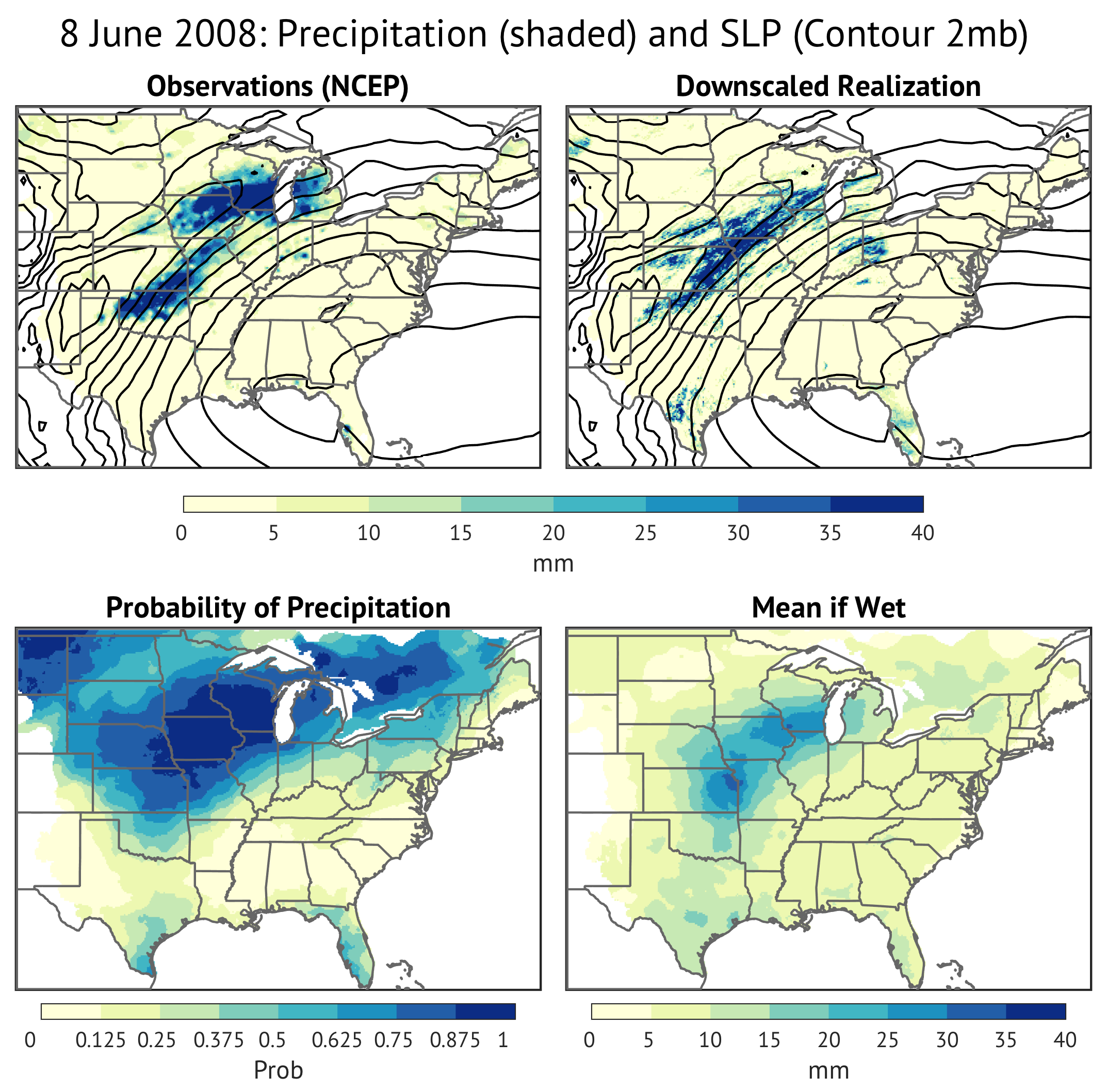Research Themes:
- Climate Dynamics (especially ocean / atmosphere interactions)
- Interactions between Weather and Climate
- Climate impacts on regional and global scales

Tropical Ocean / Atmosphere Interactions
The ocean and atmosphere are tightly coupled in the tropics, which leads to interesting phenomena like ENSO and the Pacific and Atlantic Meridional Modes. Our work focuses on these two dominant modes of variability in the tropics and their interaction. Note that I also maintain a Meridional Mode Website here: http://www.aos.wisc.edu/~dvimont/MModes/Home.html
We use a variety of tools to better understand meridional mode variability and growth. We support our observational analyses with designed numerical modeling experiments, and development of theoretical models that describe meridional mode propagation and growth. These models show that meridional modes are probably not pure eigenmodes of a a dynamical system, but rather experience growth and propagation through transient processes (modal interactions). We have developed analytical models that describe that transient growth process via atmospheric Rossby and Kelvin wave structures, as well as in physical space via potential vorticity arguments. These models explain why equatorially anti-symmetric or symmetric structures tend to emerge as dominant structures in the tropics, depending on features of the mean state and coupling.
In addition to meridional mode variability, recent research has examined mid-latitude connections to tropical climate variability in the Atlantic and Pacific, and on differences between ENSO events with "Central Pacific" and "East Pacific" characteristics.

Tropical Cyclones and Climate
Longer time scale climate variations can set up environmental conditions that may be more or less favorable for development of specific weather events. My research investigates physical mechanisms that link “climate” and “weather”, such as Meridional Mode environmental conditions that are favorable for tropical cyclone activity in the Atlantic. Tropical Atlantic climate variations associated with the Atlantic Meridional Mode influence a variety of large-scale environmental conditions in the Tropical Atlantic that are relevant for hurricane formation (Vimont and Kossin, 2007). This results in changes in hurricane genesis location, and hence duration and maximum lifetime intensity (see figure above).
Sub-seasonal to Seasonal Predictability
Subseasonal to seasonal (S2S) predictability faces a unique set of forecast challenges related to initialization, parameterization, and development of model bias around which the forecast state must evolve. We are examining the relative roles of tropical vs. midlatitude processes, and the influence of model bias, in predictability of blocking events on S2S time scales. To investigate blocking events, we develop a set of "blocking norms" that allow us to focus on specific types of events. The role of model bias is investigated by separately developing Linear Inverse Models around the observed, and around model-biased, mean states. This project is just beginning with Brett Hoover (SSEC), Michael Morgan (UW AOS), and Matt Newman (NOAA ESRL).
Jet Stream Variations
The Pacific Jet Stream occasionally undergoes a rapid retraction from a zonally elongated state to a zonally truncated state. This appears to be strongly related to the subsequent development of synoptic cyclone activity, especially the development of Kona Lows. With Jonathan Martin as lead, we are currently investigating the dynamics and impacts of these retraction events.

Climate variability and change impact our society in ways that can rarely be understood with a disciplinary, or linear approach. Instead, I work in interdisciplinary settings in which interactions between different disciplines are necessary for defining disciplinary knowledge gaps, addressing those gaps, and assimilating information in order to address specific problems. My work includes co-directing the Wisconsin Initiative on Climate Change Impacts (WICCI) and the WICCI Climate Working Group, developing probabilistic downscaling methods for climatic downscaling (with a focus on extreme events), and understanding ENSO impacts on rice production in Indonesia.
My understanding of WICCI’s organizational structure follows very closely the literature on Collective Impact Organizations (Kania and Kramer, 2011) and complex-adaptive systems. Consistent with collective impact, WICCI is a broad, semi-open, decentralized network that is served by a centralized, non-prescriptive infrastructure. This approach is especially powerful because it is inclusive (the open network approach), adaptive (as new research needs emerge WICCI easily connects with existing expertise), and preserves autonomy of the participating individuals and groups (this avoids issues of “territory” and attribution). We also recognize that WICCI exists as an organization within a constantly evolving complex adaptive system. In such a system, one role of the organization is to ensure that new ideas and needs are identified and communicated within the network and with relevant outside expertise (Rammel et al., 2007). WICCI accomplishes that role using a variety of methods across a hierarchy of scales that follow many of the ideas found in research on complex adaptive systems and collective impact. Ultimately, WICCI has been very successful in enabling climate adaptation in Wisconsin and the region, including contributing to K-12 educational materials, developing decision support tools for coastal management, evaluating infrastructure decisions for stormwater management, community planning, providing a scientific basis for WDNR land priorities, and much more.
My experience with WICCI has provided me with important experiences that I bring to efforts at climate impacts research. In particular, I recognize that any broad-scale effort should be inclusive of existing disciplinary and interdisciplinary research and decision-making activities, and should bring value to those efforts. Additionally, I recognize that no single approach is optimal for addressing specific climate impacts. Instead, I value a diverse set of approaches that allow specific efforts to move forward in ways that best meet the needs and constraints of the situation.
More information about WICCI can be found at: http://www.wicci.wisc.edu/
Results from the downscaled data are shown in a variety of ways here (thanks to Michael Notaro): http://nelson.wisc.edu/ccr/resources/LCC/index.php
Details about the statistical downscaling methodology are provided here (thanks to David Lorenz): https://djlorenz.github.io/downscaling2/main.html
